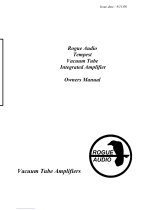
GENERAL INFORMATION
4
HOT AIR
VS INFRARED
WHAT MAKES
TEMPEST
®
WORK
Although the technology behind the Tempest
®
dryer was significant
enough to be awarded the GATF Intertech Award, it is by no means
new. In fact, thermistors have been in use for many years. They
were originally used in motors and other devices as a heat
controller and later used in refrigeration to turn compressors on and
off. It is only in the last 10 years or so that thermistors have been
used as a heater.
Heat is generated by the thermistor because of the difficulty of
electricity travelling through it when it is a conductor. The thermistor
acts as a conductor until it reaches its set temperature and then it
becomes a resistor. A thermistor is basically a coated
semiconductor designed to switch from a conductor to a resistor at
an established temperature.
When a current is applied to the thermistor it initially uses a large
amount of electricity and heats up very quickly until it reaches its
maximum set temperature. At this point it should not use any more
electricity. However, air that is passed through the holes in the
thermistor causes it to cool. This activates the thermistor to start
using more power again so that can get back to its set temperature.
The thermistor is constantly regenerating itself to stay at a constant
temperature. This process is called autostabilization.
Thermistors are also the key element that makes the Tempest
®
dryer safe. Because the set temperature of the thermistor is lower
than the flash point of paper, you can place even the most easily
burned substrate (such as tissue paper) on top of the thermistor
element without causing a fire. The tissue won't even char, let
alone ignite. If you were to do the same with an IR element, a fire
could start in a matter of seconds. This is particularly important if a
jam occurs in the delivery.
The objective of any drying system is to raise the pile temperature
to accelerate the drying of the ink. However, heating the paper too
much can aggravate problems such as blocking, setoff, mottle, loss
of gloss, and loss of halftone definition. Too much heat can also
cause the paper to shrink which can cause register problems in
multiple pass work. The Tempest
®
dryer can keep the pile at a
lower temperature than IR and still effectively set the ink film.






















